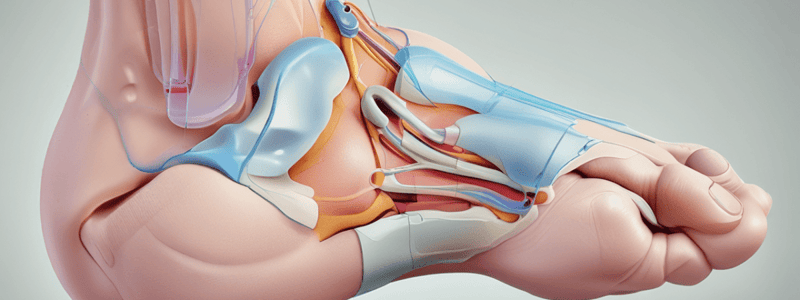Podcast
Questions and Answers
What is the primary type of motion exhibited by the first 20-30° of hallux dorsiflexion?
What is the primary type of motion exhibited by the first 20-30° of hallux dorsiflexion?
- Rotational
- Rolling (correct)
- Sliding
- Circular
What is the primary function of the cam-shaped 1st metatarsal head?
What is the primary function of the cam-shaped 1st metatarsal head?
- To reduce compression at the end range of motion
- To increase the range of motion
- To aid in the rolling motion of the 1st MTPJ (correct)
- To facilitate first ray plantarflexion
What is the normal range of motion of the 1st MTPJ?
What is the normal range of motion of the 1st MTPJ?
- 70-80°
- 65-75° (correct)
- 50-60°
- 60-70°
What type of joint is the 1st MTPJ classified as?
What type of joint is the 1st MTPJ classified as?
What occurs at the end range of motion in the 1st MTPJ?
What occurs at the end range of motion in the 1st MTPJ?
What is the primary function of the peroneus longus tendon in relation to the 1st ray?
What is the primary function of the peroneus longus tendon in relation to the 1st ray?
What is the result of the wedge-shape of the middle and lateral cuneiforms?
What is the result of the wedge-shape of the middle and lateral cuneiforms?
What is the primary characteristic of Hallux Rigidus?
What is the primary characteristic of Hallux Rigidus?
What is the role of the normal parabola in the medial column?
What is the role of the normal parabola in the medial column?
What is the purpose of the Windlass mechanism?
What is the purpose of the Windlass mechanism?
What is the relationship between the medial cuneiform and cuboid?
What is the relationship between the medial cuneiform and cuboid?
What is the result of not meeting the requirements for normal 1st MTPJ ROM?
What is the result of not meeting the requirements for normal 1st MTPJ ROM?
What is the degree of dorsiflexion reduction caused by a 1-inch heel?
What is the degree of dorsiflexion reduction caused by a 1-inch heel?
What is the effect of immobilization of the 1st ray in dorsiflexion on the 1st MTPJ?
What is the effect of immobilization of the 1st ray in dorsiflexion on the 1st MTPJ?
What is the term used to describe the condition where the hallux is unable to dorsiflex due to the blocking of the windlass mechanism?
What is the term used to describe the condition where the hallux is unable to dorsiflex due to the blocking of the windlass mechanism?
What is the purpose of the windlass mechanism in the 1st MTPJ?
What is the purpose of the windlass mechanism in the 1st MTPJ?
What is the characteristic of functional hallux limitus?
What is the characteristic of functional hallux limitus?
What is the goal of orthotic management in treating hallux rigidus?
What is the goal of orthotic management in treating hallux rigidus?
What is the effect of Morton's extension on the 1st MTPJ?
What is the effect of Morton's extension on the 1st MTPJ?
What is the purpose of the reverse Morton's extension?
What is the purpose of the reverse Morton's extension?
What is the goal of surgical treatment options for hallux rigidus?
What is the goal of surgical treatment options for hallux rigidus?
What is the primary indication of a Stage 1 functional limitus in the Drago, Oloff, & Jacobs Classification?
What is the primary indication of a Stage 1 functional limitus in the Drago, Oloff, & Jacobs Classification?
Which of the following is NOT a characteristic of Stage 2 adaptation in the Drago, Oloff, & Jacobs Classification?
Which of the following is NOT a characteristic of Stage 2 adaptation in the Drago, Oloff, & Jacobs Classification?
What is the primary difference between Stage 3 deterioration and Stage 4 ankylosis in the Drago, Oloff, & Jacobs Classification?
What is the primary difference between Stage 3 deterioration and Stage 4 ankylosis in the Drago, Oloff, & Jacobs Classification?
What is the treatment for Stage 1 functional limitus in the Drago, Oloff, & Jacobs Classification?
What is the treatment for Stage 1 functional limitus in the Drago, Oloff, & Jacobs Classification?
Which stage of the Drago, Oloff, & Jacobs Classification is characterized by crepitus and subchondral cystic formation?
Which stage of the Drago, Oloff, & Jacobs Classification is characterized by crepitus and subchondral cystic formation?
What is the characteristic deformity seen in Stage 4 ankylosis in the Drago, Oloff, & Jacobs Classification?
What is the characteristic deformity seen in Stage 4 ankylosis in the Drago, Oloff, & Jacobs Classification?
Flashcards are hidden until you start studying




